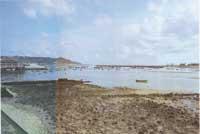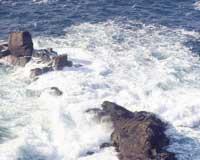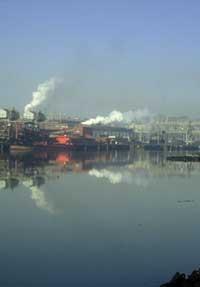Estuaries: young but complex ecosystems
1996/06/01 Villate, Fernando Iturria: Elhuyar aldizkaria
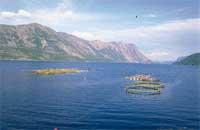
At the limit of land and sea, estuaries are formed by the mixture of river waters with marine waters. However, the search for an adequate definition of these systems is not easy, since a common definition can hardly encompass the complexity of the transition systems between land, sea and freshwater. However, and accepting that it offers little detail, the most acceptable definition would be as follows: “The estuary is a semi-circular coastal water zone, connected to the open sea, in which seawater is clearly diluted with the drainage basin water.”
Estuaries and geomorphology training
Most of today's estuaries are young systems, emerged after the last glaciation, as a result of the rise in sea level, between 10,000 and 15,000 years ago.
This increase in the sea caused the sinking of the old vegas and the appearance of the estuaries of the coastal plain. These are found in temperate latitudes and are formed by new sediments, so the depth is not usually high.
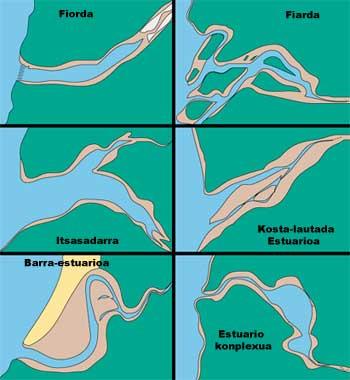
In high latitudes, sunken glacial valleys form fjords. In these deep estuaries the bottom is mostly rocky and the discharge of the river is small compared to the total volume of fjords. Fiards are systems created in the lower fields that suffered glaciations and more superficial and complex than fjords, sometimes without main channel.
Rías have characteristics common to fjords and fjords, but they are not those created by glaciers. In these estuaries that have been formed by sinking of the coast or by increasing the level of the sea, the depth and the bottom are mostly rocky, with a much greater influence of the sea than that of the river.
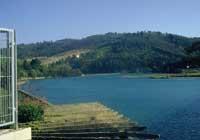
On stable coasts, when the active accumulation of sediments is such, the barn estuaries appear, which due to the sand bar generated by the waves, are almost isolated from the sea. They are shallow systems in which the transport and accumulation of sediments is variable and meandriform channels and mouth displacements are generated.
Systems that generate classification problems in these categories are grouped into the complex estuary group. Although in most cases they resemble the estuaries of the coastal plain, their characteristics are not homogeneous, which indicates that the generation processes have been very different.
Environment characteristics
Tides and their influence
The estuary name itself comes from the Latin aestus (tide), which indicates that one of the most important characteristics of these systems is the tide. But the influence of the tide is not always the same, since depending on the place its amplitude varies from a few centimeters to about 15 meters, as in the Canadian bay of Fundy. Based on this factor, estuaries are classified into the following categories: microtidal, when the amplitude in live tide is less than 2 meters, mesotidal, when the amplitude of live tides ranges between 2 and 4 meters and macrotidal, when in live tides there are amplitudes greater than 4 meters.
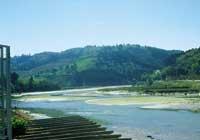
The influence of tide on the community and the functioning of the system depends on the size of the estuary. It is meant that the influence of tide can be low in deep microtidal estuaries, but in shallow macrotidal systems biological processes are subjected to tidal control. These tidal systems generate violent currents and wide and unstable intertidal zones.
In general, tide changes, along with variations in river runoff, cause instability that makes the situation in estuaries always variable.
Salinity and water circulation
The sea water is diluted with the fresh water of the rivers in the estuaries, but this process is not homogeneous because it depends, among other things, on the volume of fresh water, the width of tide and the evaporation of water. Since the salinity of sea water is around 35‰ and that of freshwater below 0.5‰, the salinity waters between the two values are brackish. As a result of evaporation, hyperhaline waters with salinity above 40‰ appear in some cases.
According to salinity, two main types of estuaries are distinguished: positive and negative (see chart above). The fresh water that penetrates the positive estuaries, being less dense than the saline of water, is directed superficially towards the sea, mixing with the marine water that moves from the bottom towards the interior. Therefore, the waters of higher salinity are in the outer bottom and the waters of lower salinity on the inner surface. When the evaporation in the estuary is greater than the entry of fresh water, a negative estuary occurs, since by increasing salinity and density due to evaporation, the surface water sinks and heads towards the sea. This type of estuaries is only found in the tropics.
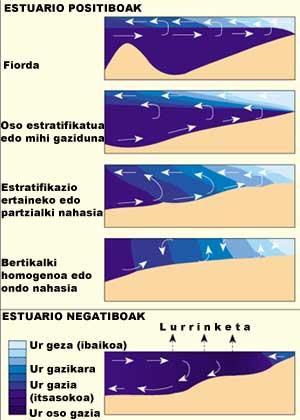
Different circulation patterns may appear in positive or common estuaries. When river flows are much larger than tide flows, surface water maintains a permanent flow to the sea. In these cases, the vertical salinity gradient is usually violent, keeping at the bottom the tongue of marine salt water to the interior of the estuary. Therefore, these estuaries are classified into a very stratified category or with salty tabs. Some fjords, in addition to being very stratified, have a very low renewal rate in the bottom waters, since the underwater rock barrier located in the mouth (accumulation of stones transported by glaciers) prevents the circulation of the tide.
When the flow into the tide is equal to or greater than the river flow, partially mixed or medium-stratified estuaries are formed. In them the mixture of sea-river waters is continuous and in any part of the estuary, although the salinity of surface waters is less than that of the bottoms, fresh water is only found inside the estuary.
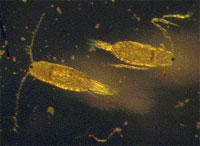
In large but shallow estuaries, the salinity gradient is horizontal and estuaries are formed vertically homogeneous or well mixed. In these estuaries, by the force of Coriolis, the flow to the sea in the northern hemisphere occurs by the right and by the left and vice versa in the southern hemisphere.
In addition to the factors mentioned, the circulation area of the estuary may vary depending on the time. For example, they can go from being partially mixed in dry form to being stratified in rainy season.
Sediments
The particles that carry rivers and seas, as well as those from erosion in the estuary margin, can accumulate in the estuary in different places and proportions, depending on the hydrodynamism of each estuary and the geomorphology of the basin.
The fine clay particles carried by the river only settle in areas where the current slows down. Therefore, the most muddy sediments appear in the stagnant waters that form when river currents meet tide currents. In areas where tidal currents predominate, clean sandy sediments appear. Gravel or rock beds may also appear in areas subject to strong tidal or river flows.

In general, muddy sediments dominate river estuaries, while marine sands predominate in submarines. In balanced estuaries the complexity of the sediments is greater, predominating the sand on the outside and the mud on the inside.
Living beings from estuaries
As already indicated, estuaries are transition zones between rivers and seas, so it is evident that saline variability, the very low tides and the mobility of sediments, impose a harsh environment to the beings who have adapted to live there. Salinity delimits the activity and distribution of both the water column (planktonic organisms and fish) and the hard substrate beings. For animals living in soft sediments, salinity is unimportant, as salinity in interstitial water is more stable. In this case, sediment characteristics (particle size, mobility, exposure, etc.) are the main agents.
In general, among the plants and animals present in the estuaries are the limnetic organisms, that is, those of the river or fresh water, while most organisms cannot withstand a salinity greater than 5‰ and, if it appears, only appear inside. However, only some species, oligohalines, can remain in waters with salinity higher than 5‰, although their optimal development ranges from 0.5‰ to 5‰. The optimal development of strict estuarine organisms or true estuarine is concentrated in salobres between 5‰ and 18‰ and is located in the center of the estuary.
Although most are able to live in marine waters, they face marine species. The most abundant group of species in estuaries is that of sea-pluvial organisms. These species usually extend from the sea to the center of the estuaries and are able to remain in salinity waters of 5‰.
Stenohaline marine organisms, on the other hand, are scarcer, appearing only on the outside and waters higher than 25‰. In addition to these categories, migrants are important members of the estuarine community. These animals, mainly decapod fish and crustaceans, are intermittent inhabitants, since when they go from the sea to rivers or rivers to fertilization, they use the estuary as a way.
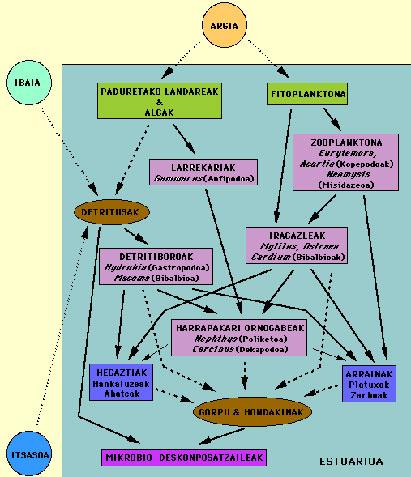

Gai honi buruzko eduki gehiago
Elhuyarrek garatutako teknologia




